All of them are. It's just a different type of balance. All organisms processing incoming food and outgoing. You can toss that balance out of whack with too much food. Or too little. And by food I mean shrimp.My tank is a text book example of that theory.
Navigation
Install the app
How to install the app on iOS
Follow along with the video below to see how to install our site as a web app on your home screen.
Note: This feature may not be available in some browsers.
More options
You are using an out of date browser. It may not display this or other websites correctly.
You should upgrade or use an alternative browser.
You should upgrade or use an alternative browser.
Spectrum and Dinoflagellate Outbreak?
- Thread starter Dana Riddle
- Start date
- Tagged users None
- Joined
- Sep 8, 2015
- Messages
- 6,514
- Reaction score
- 6,511
And by shrimp, what kind of shimp? lolAll of them are. It's just a different type of balance. All organisms processing incoming food and outgoing. You can toss that balance out of whack with too much food. Or too little. And by food I mean shrimp.
And by shrimp, what kind of shimp? lol
It depends.And by shrimp, what kind of shimp? lol
jsker
Reefing is all about the adventure
View Badges
Staff member
Super Moderator
Partner Member 2024
Excellence Award
Reef Tank 365
Article Contributor
Hospitality Award
Ocala Reef Club Member
R2R Secret Santa 2023
My Tank Thread
My tank is a text book example of that theory.
I used what you were doing, letting the tank correct itself, and reading post from members.
Jason Fox uses Blue+ T5s, not True Actinic.2) a recent video of Jason Fox’s tanks show he uses pure actinics
The real issue here, if we’re going to try and move from an idea to hypothesis/theory/law... is that correlation does not equal causation, and while we can see some pretty convincing correlation, there are so many variables in our mini reefs, and plenty that we can’t even measure, that even in the most simple systems, it’s really difficult to say conclusively that we have eliminated all possible variables and can show causation.
It’s fun to get as close as we can, and we have certainly come a long way, but this is really difficult from and strictly scientific approach.
jsker
Reefing is all about the adventure
View Badges
Staff member
Super Moderator
Partner Member 2024
Excellence Award
Reef Tank 365
Article Contributor
Hospitality Award
Ocala Reef Club Member
R2R Secret Santa 2023
My Tank Thread
YesMy tank is a text book example of that theory.
- Joined
- Sep 8, 2015
- Messages
- 6,514
- Reaction score
- 6,511
@Dana Riddle If we can make any assessment, it's not the classic case of dinos. I suppose the debate now would either be calothrix or diatoms. Maybe @jason2459 can give some insight??
Here's a quick and dirty photomicrograph I took of the stringy 'snot alga' causing the issues in my tank. Based on literature readily available to hobbyists (such as myself), this is identified as a benthic dinoflagellate. I'll leave ID up to those more well versed in dinoflagellate taxonomy if indeed that's what it is. Any help appreciated!

Thank you, and thank you!
Thanks!Thanks for tagging me, this is cool.
The Q of spectrum had been dismissed by people trying to get rid of dinos because it was posed "what spectrum do dinos not do well in" and the answer is none. Dinos grow under every kind of lighting system in the hobby.
But does a part of spectrum FAVOR dinos? Read on for what could be a mechanism.
Most green algae has chlorophyll-powered photosynthetic machinery. Dinos/coral have peridinin in addition to chlorophyll, and it lets dinos use different parts of spectrum.
Check this article - how dinoflagellates make light work with peridinin - http://www.cell.com/trends/plant-science/abstract/1360-1385(96)81769-9
"[Peridinin-Chlorophyll Proteins]...can be tuned to absorb in regions where chlorophylls cannot (480-550nm)"
So it seems like blues-only light is another circumstance (in addition to some nutrient situations) that would allow dinos to thrive while their green algae competitors suffer.
This would not explain a 1 day "explosion" of dinos, but it would explain a days to weeks long dino takeover.
Is it possible to get a picture of the growth?
I would like to play with the concept that this could be a misdiagnosis. Is seems more coincidental with the lighting rather than the catalyst.
I'll tell a little short story about my dry rock and bagged live sand experience.
Feb 1st or day that water was added.
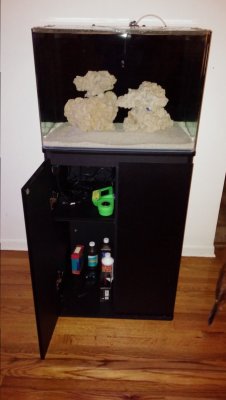
March 1st. Diatom bloom. Few coral added.
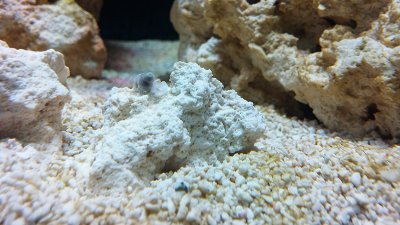
The diatom bloom lingered for a couple months. I neglected to visually document it until June and decided to take pictures for more insight as it was growing uncontrollably. But because the growth had bubbles and information was limited I went to dinoflagellate threads for help.
June misdiagnosis growth.
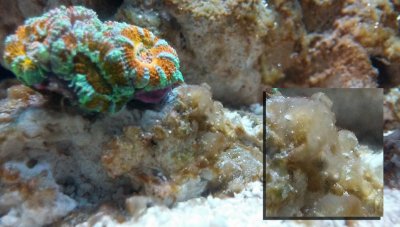
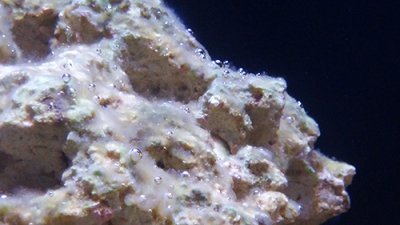
I sent a sample to a fellow reefer here named Todd Williard or commonly known as twilliard.
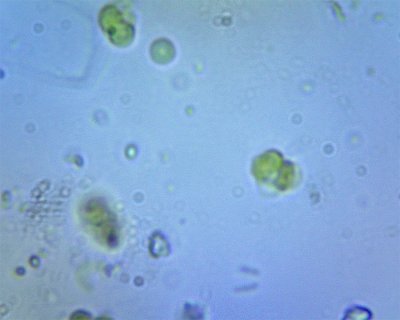
The chlorophyll presence in the sample led us to research that eventually turned into identifying as Chrysophytes.
Not much information on them but a common disturbance with this growth is large amounts of silicates and that part is the short version. Ripping my hair out with this growth brought me to an article by a well known reefer who specializes in lighting. His name is Dana Riddle ;Hilarious. His article, Aquarium Chemistry: Effects of GFO (Granular Ferric Oxide) on 'Trace' Metals Concentrations in Artificial Seawater, has the key(believe it or not) to eradicating Chrysophytes. A three day black out, with 24 hours of max GFO, and a water change will cure this growth.
However, the side effect from treatment is getting the tank back on track with maturing.
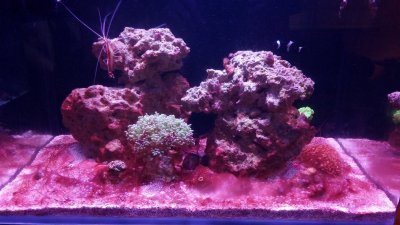
And eventually it clears up.
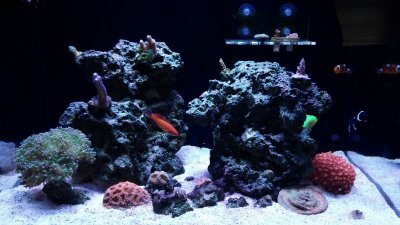
However, in my tanks history and after all these changes, the rock(picture above) in the lower left hand corner was a dense base rock with no holes or water to flow through. So I removed the rock to break it down. Come to find out, the rock won't break. The chisel just embeds and white milky stuff comes out.
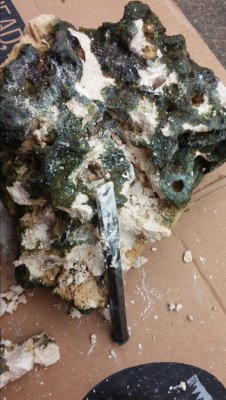
So I cured more dry rock separately in a brute can for a little longer than a month. Seeding bacteria and doing small water changes. I also soaked the rock with GFO to limit silicates and phosphates that were known to leach. About two weeks after adding the new rock to the tank. Dinoflagellates.
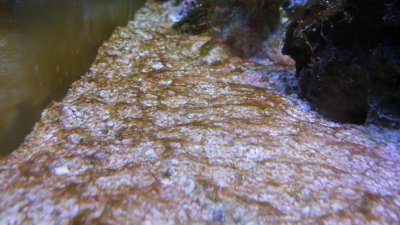
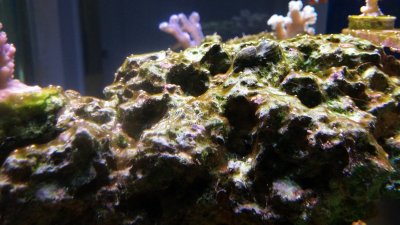
I didn't want to share the tanks entire history but this is the picture heavy short story version. I did this to not only show the worst outcomes from dry rock tanks but to make sure that something isn't getting misidentified.

OK - This thread is taking usual twists, turns, tangents... Which is a good thing. It now appears there may be a misdiagnosis of the culprit. I've got some feelers out for confirmation of ID. More soon, and thanks for everyone's comments and help!
Here's another theory after thinking of another spectrum thread....
I've read that dino's have a really low light compensation point. What if removing red light ruins their use of photosynthsis because of hte PSI and PSII regulation issues?
Maybe that's all it would take to trigger a switch in dino's to phagotrophy and a subsequent bloom?
I suppose this theory may not be limited to just dino's.....whatever the critter is.
I've read that dino's have a really low light compensation point. What if removing red light ruins their use of photosynthsis because of hte PSI and PSII regulation issues?
Maybe that's all it would take to trigger a switch in dino's to phagotrophy and a subsequent bloom?
I suppose this theory may not be limited to just dino's.....whatever the critter is.
I went through a similar experience. Newly set up tank that I had a cheap fluorescent light strip on until I was ready to add corals. When I got my new Viparspectra LED I had an outbreak of dinoflagellates. I adjusted the intensity of the lights to 40% blues and 10% full spectrum as I was advised to do by a friend. I couldn't seem to get rid of it. Nitrates and phosphate were reading 0, but still no improvement. The only thing that helped me was manually removing as much as I could, then stirring the sand bed every other day. The lights are back at 90% blue and 80% FS. 2 weeks now and they haven't returned. I'm curious if it's related to insufficient oxygenation of the sand bed and trapped detritus?
- Joined
- Sep 8, 2015
- Messages
- 6,514
- Reaction score
- 6,511
If you were using any GFO, denitrate media, or carbon dosing with the addition of more adequate par for coral to consume nutrients, all together was a smoking gun. Low nutrients don't help get rid of dinos but when nutrients are the limiting factor, they actually thrive in these conditions feeding on available fish food and microbial life forms that would normally out compete dinos.I went through a similar experience. Newly set up tank that I had a cheap fluorescent light strip on until I was ready to add corals. When I got my new Viparspectra LED I had an outbreak of dinoflagellates. I adjusted the intensity of the lights to 40% blues and 10% full spectrum as I was advised to do by a friend. I couldn't seem to get rid of it. Nitrates and phosphate were reading 0, but still no improvement. The only thing that helped me was manually removing as much as I could, then stirring the sand bed every other day. The lights are back at 90% blue and 80% FS. 2 weeks now and they haven't returned. I'm curious if it's related to insufficient oxygenation of the sand bed and trapped detritus?
Ive only seen outbreaks increase in areas of low flow when i feed extra or reduce export.
If any thing, higher intensity light of any spectrum to areas of high nutrients and low flow will cause problems.
If any thing, higher intensity light of any spectrum to areas of high nutrients and low flow will cause problems.
- Joined
- Sep 8, 2015
- Messages
- 6,514
- Reaction score
- 6,511
Sounds like cyano.Ive only seen outbreaks increase in areas of low flow when i feed extra or reduce export.
If any thing, higher intensity light of any spectrum to areas of high nutrients and low flow will cause problems.
Or DiatomsSounds like cyano.
- Joined
- Sep 8, 2015
- Messages
- 6,514
- Reaction score
- 6,511
Yes, or diatoms lol. It's always best to keep a microscope on hand. Even the $10 toy ones from amazon are adequate enough to ID.Or Diatoms
I would but ive become an expert at eliminating such problems (cyano and diatoms, not sure if ive ever really had dinos).Yes, or diatoms lol. It's always best to keep a microscope on hand. Even the $10 toy ones from amazon are adequate enough to ID.
Last edited:
Or Diatoms
Both and Dino's.Yes, or diatoms lol. It's always best to keep a microscope on hand. Even the $10 toy ones from amazon are adequate enough to ID.
And then some fade almost instantly.
Nice thing about R2r. You see constant data points. Pictures.
Some fade immediately as if they used up the food. Some linger.
One case Brandon 429 and I worked on took months and no respite. Nothing worked.
In hindsight , it had to be rotten rock. Something had to be in it.
That makes sense. The harder I fought to reduce the nutrients, the worse it got. Thanks for the explanation. I was stumped.If you were using any GFO, denitrate media, or carbon dosing with the addition of more adequate par for coral to consume nutrients, all together was a smoking gun. Low nutrients don't help get rid of dinos but when nutrients are the limiting factor, they actually thrive in these conditions feeding on available fish food and microbial life forms that would normally out compete dinos.
Similar threads
- Replies
- 0
- Views
- 98
- Replies
- 25
- Views
- 1,556
- Replies
- 31
- Views
- 1,110
- Replies
- 3
- Views
- 377
- Replies
- 10
- Views
- 259


















